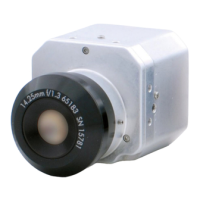55
History and Theory of Infrared Technology
Should the source be a graybody with
emittance ε, the received radiation would
consequently be εW
source
.
We are now ready to write the three
collected radiation power terms:
Emission from the object1. = ετW
obj
, where
ε is the emittance of the object and τ is
the transmittance of the atmosphere.
The object temperature is T
obj
.
Reected emission from ambient sources2.
= (1 – ε)τW
re
, where (1 – ε) is the
reectance of the object. The ambient
sources have the temperature T
re
.
It has here been assumed that the
temperature T
re
is the same for all
emitting surfaces within the half-
sphere seen from a point on the object
surface. This is of course sometimes a
simplication of the true situation. It
is, however, a necessary simplication
in order to derive a workable formula,
and T
re
can – at least theoretically – be
given a value that represents an ecient
temperature of a complex surrounding.
Note also that we have assumed that the
emittance for the surroundings = 1. This
is correct in accordance with Kirchho’s
law: All radiation impinging on the
surrounding surfaces will eventually
be absorbed by the same surfaces.
Thus the emittance = 1. (Note, though,
that the latest discussion requires the
complete sphere around the object to be
considered.)
Emission from the atmosphere3. =
(1 – τ)τW
atm
, where (1 – τ) is the
emittance of the atmosphere. The
temperature of the atmosphere is T
atm
.
The total received radiation power can
now be written (Equation 2):
W
tot
= ετW
obj
+ (1 – ε)τW
re
+ (1 – τ)W
atm
We multiply each term by the constant
C of Equation 1 and replace the CW
products by the corresponding U
according to the same equation, and get
(Equation 3):
U
tot
= ετU
obj
+ (1 – ε)τU
re
+ (1 – τ)U
atm
Solve Equation 3 for U
obj
(Equation 4):
1 1 – ε 1 – τ
U
obj
=
___
U
tot
–
_____
U
re
–
_____
U
atm
ετ ε ετ
This is the general measurement
formula used in all the FLIR Systems
thermographic equipment. The voltages
of the formula are given in Table 1.
Table 1. Voltages
U
obj
Calculated camera output voltage for a
blackbody of temperature T
obj
, which is a
voltage that can be directly converted into
true requested object temperature.
U
tot
Measured camera output voltage for the
actual case.
U
re
Theoretical camera output voltage for a
blackbody of temperature T
re
according to
the calibration.
U
atm
Theoretical camera output voltage for a
blackbody of temperature T
atm
according to
the calibration.
The operator has to supply a number of
parameter values for the calculation:
object emittance ε•
relative humidity•
T•
atm
object distance (D•
obj
)
(eective) temperature of the object •
surroundings or the reected ambient
temperature T
re
the temperature of the atmosphere •
T
atm

